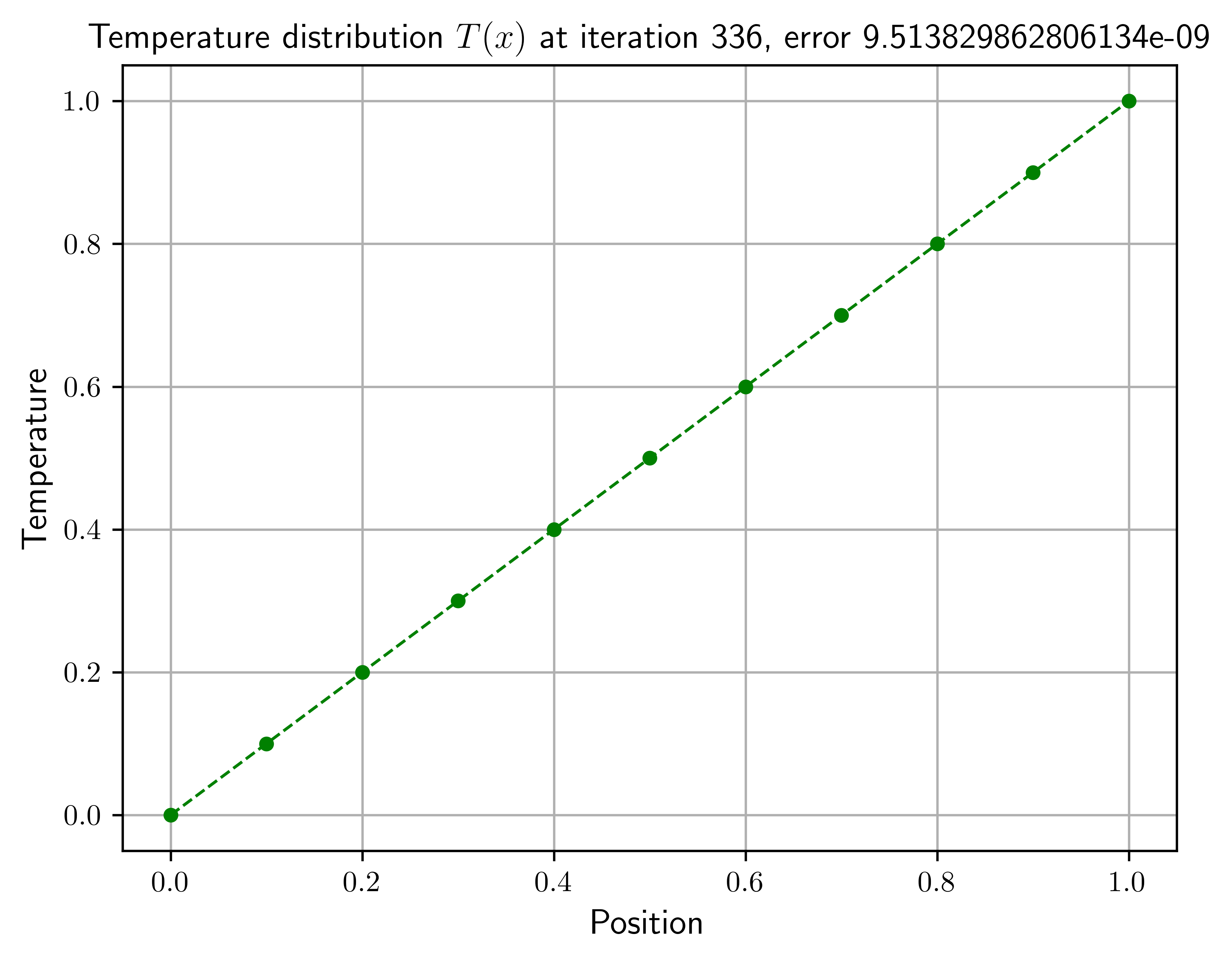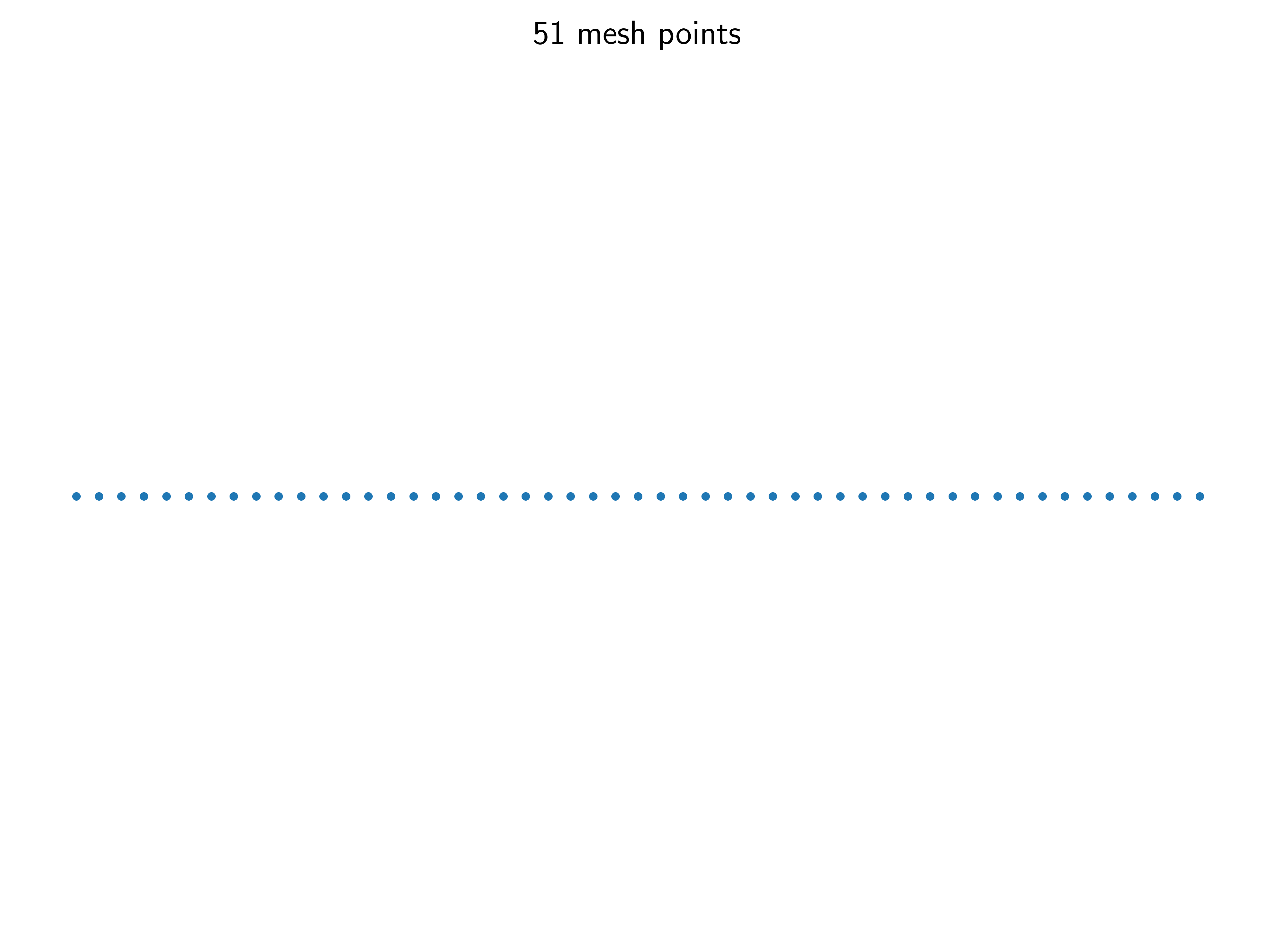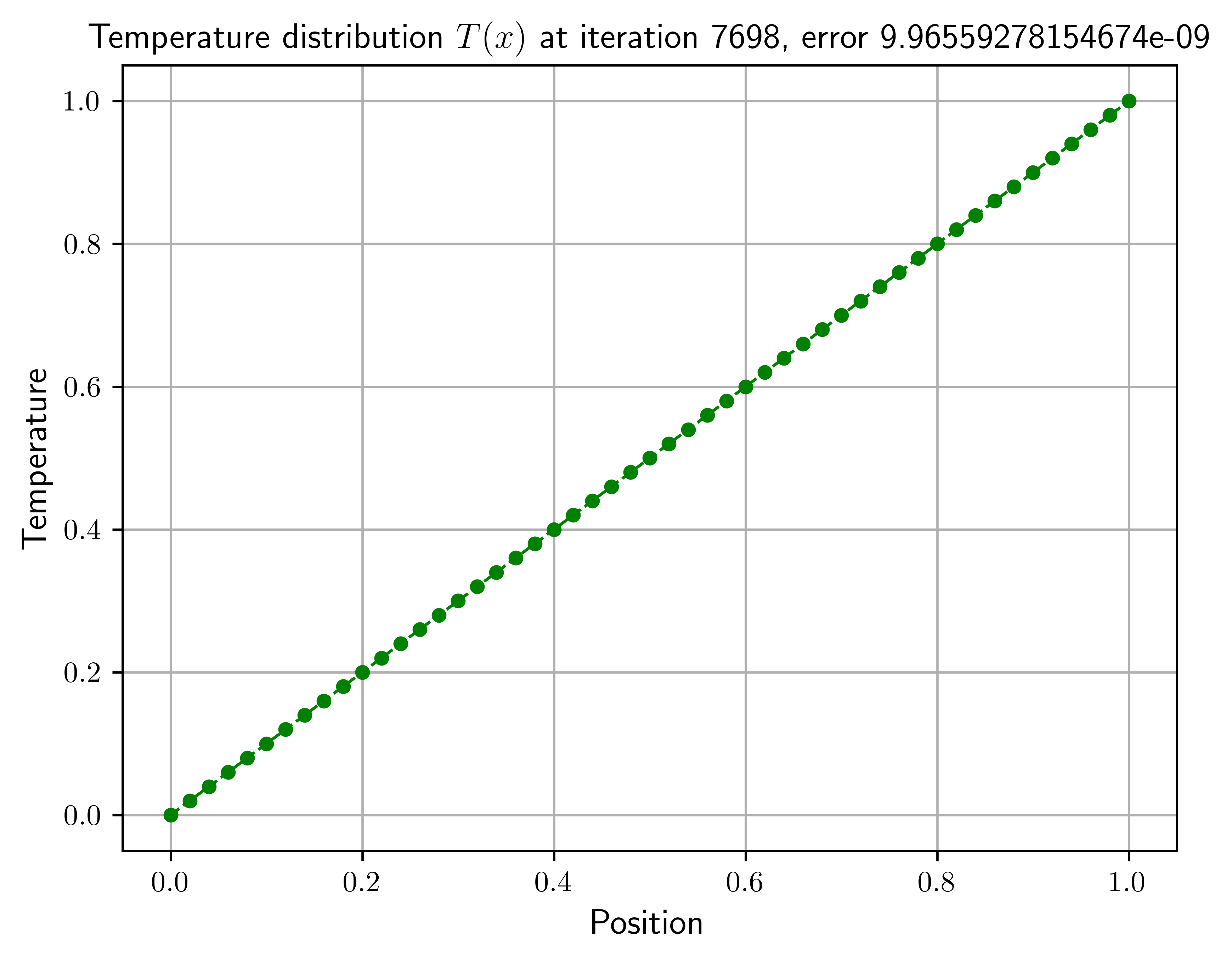21. Second derivative - 1D heat conduction#
21.1. 1D Heat Condution#
Given: The physics of the situation is governed by the differential equation of pure diffusion:
\[
\dfrac{\mathrm{d}^2 T\left(x\right)}
{\mathrm{d}x^2}=
0
\]
subject to the
Initial condition: \(T\left(x\right)=0\) for \(x < 1\).
Boundary conditions: \(T\left(0\right)=0\), \(T\left(1\right)=1\).
Objective: To calculate the temperature distribution, \(T\left(x\right)\) at equilibrium.
21.2. Finite Difference Solution#
Convert physical geometry into a computational mesh.
Discretize the governing equation on this mesh using a numerical scheme.
\[
\dfrac{\mathrm{d}^2 T\left(t, x\right)}
{\mathrm{d}x^2}\approx
\dfrac{T_{i+1}-2T_i+T_{i-1}}{{\left(\Delta x\right)}^{2}}=
0.
\implies
T^{\left(k+1\right)}_{i}\approx
\dfrac{1}{2}
\left(T^{\left(k\right)}_{i+1}+T^{\left(k\right)}_{i-1}\right).
\]
from typing import Tuple
import matplotlib.pyplot as plt
import numpy as np
def pure_diffusion_solver(
number_samples: int = 51, tolerance: float = 1e-8, max_iterations: float = 78000
) -> tuple[int, float, np.array]:
x = np.linspace(start=0, stop=1, num=number_samples)
iteration = 0
numeric_error = 1.0
T = np.zeros_like(x)
T[-1] = 1 # Initial condition
T_new = T.copy()
while (numeric_error > tolerance) and (iteration < max_iterations):
T_new[1:-1] = 0.5 * (T[2:] + T[:-2])
numeric_error = np.sum(np.abs(T_new - T))
iteration += 1
T = T_new.copy()
return iteration, numeric_error, T
def mesh_plot(number_samples: int = 51):
x = np.linspace(start=0, stop=1, num=number_samples)
y = np.zeros_like(x)
fig, ax = plt.subplots()
fig.set_tight_layout(True)
ax.scatter(x=x, y=y, s=4)
ax.set_title(f"{number_samples} mesh points")
ax.axes.get_xaxis().set_visible(False)
ax.axes.get_yaxis().set_visible(False)
ax.set_frame_on(False);
def pure_diffusion_plot(number_samples: int = 51):
iteration, numeric_error, T = pure_diffusion_solver(number_samples=number_samples)
x = np.linspace(start=0, stop=1, num=number_samples)
fig, ax = plt.subplots()
ax.plot(x, T, "go--", linewidth=1, markersize=4)
ax.set_xlabel("Position", fontsize=12)
ax.set_ylabel("Temperature", fontsize=12)
ax.grid()
ax.set_title(
f"Temperature distribution $T(x)$ at iteration {iteration}, error {numeric_error}",
fontsize=12,
);
def heat_plot(number_samples: int = 51):
iteration, numeric_error, T = pure_diffusion_solver(number_samples=number_samples)
fig, ax = plt.subplots()
ax.imshow(T[np.newaxis], vmin=T.min(), vmax=T.max(), cmap="Reds")
ax.axes.get_yaxis().set_visible(False);
number_samples = 11
mesh_plot(number_samples=number_samples)
pure_diffusion_plot(number_samples=number_samples)
heat_plot(number_samples=number_samples)
21.3. 1D convection diffusion equation#
21.3.1. Discretization exercise#
\[
U\left(x\right)
\dfrac{\mathrm{d}T\left(x\right)}{\mathrm{d}x}+
\dfrac{\mathrm{d}^{2}T\left(x\right)}{\mathrm{d}x^{2}}
=0.
\]
Use a central difference based discretization for both the derivatives:
\[
T^{\left(k+1\right)}_{i}=
\left(\dfrac{1}{2}+\dfrac{U\left(x\right)\Delta x}{4}\right)T^{\left(k\right)}_{i+1}+
\left(\dfrac{1}{2}-\dfrac{U\left(x\right)\Delta x}{4}\right)T^{\left(k\right)}_{i-1}.
\]
def advection_solver(
number_samples: int = 11, tolerance: float = 1e-8, max_iterations: float = 300
) -> tuple[int, float, np.array]:
x, dx = np.linspace(start=0, stop=1, num=number_samples, retstep=True)
U = 1 # speed
iteration = 0
numeric_error = 1.0
T = np.zeros_like(x)
T[-1] = 1 # Initial condition
L, R = (0.5 + U * dx / 4), (0.5 - U * dx / 4)
T_new = T.copy()
while (numeric_error > tolerance) and (iteration < max_iterations):
T_new[1:-1] = L * T[2:] + R * T[:-2]
numeric_error = np.sum(np.abs(T_new - T))
iteration += 1
T = T_new.copy()
return iteration, numeric_error, T
def advection_plot(number_samples: int = 11):
iteration, numeric_error, T = advection_solver(number_samples=number_samples)
x = np.linspace(start=0, stop=1, num=number_samples)
fig, ax = plt.subplots()
ax.plot(x, T, "go--", linewidth=1, markersize=4)
ax.set_xlabel("Position", fontsize=12)
ax.set_ylabel("Temperature", fontsize=12)
ax.grid()
ax.set_title(
f"Temperature distribution $T(x)$ at iteration {iteration}, error {numeric_error}",
fontsize=12,
);







